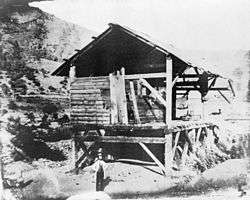Sutter's Mill
Sutter's Mill was a sawmill, owned by 19th-century pioneer John Sutter, where gold was found, setting off the California Gold Rush, a major event of the history of the United States. It was located on the bank of the South Fork American River in Coloma, California and is today part of the Marshall Gold Discovery State Historic Park.
| Sutter's Mill | |
|---|---|
 Sutter's Mill in 1850 | |
| Area | Marshall Gold Discovery State Historic Park |
| Governing body | California Department of Parks and Recreation |
| Official name: Gold discovery site | |
| Designated | March 7, 1955[1] |
| Reference no. | 530 |
History
On January 24, 1848, James Wilson Marshall, a carpenter originally from New Jersey, found flakes of gold in the American River at the base of the Sierra Nevada Mountains near Coloma, California. At the time, Marshall was working to build a water-powered sawmill owned by John Sutter. On February 2, 1848, the Treaty of Guadalupe Hidalgo was signed in Mexico City which transferred the American Southwest to the United States. When the news got out about the gold, people from all over the world headed for California, speeding statehood and permanently transforming the territory.[2] During the next seven years, approximately 300,000 people came to California (half by land and half by sea) to seek their fortunes from either mining for gold or selling supplies like food, clothing, burros, lumber, picks, and shovels to the prospectors.
Henry Bigler[3] and Azariah Smith,[4] like other workers at the mill, were veterans of the Mormon Battalion, and wrote about their experience in journals.[5] Bigler recorded the actual date when gold was discovered, January 24, 1848, in his diary. This gold find started the California Gold Rush the next year.[6]
Impact
The discovery of gold at Sutter's Mill caused a large mass of migration to California. After the finding of gold California changed dramatically, going from 14,000 non-natives to an estimated 85,000 newcomers to California in just a year.[7] Many from the eastern states dropped everything they were doing to head West in hopes of becoming rich. There was significant mass immigration of fortune-seekers from many countries, including roughly 60,000 Chinese immigrants, 7,000 Mexicans, and tens of thousands from many other countries.[7] There were roughly 81,000 newcomers in 1849 and another 91,000 in 1850.[8] Many died from turf wars over mine claims and diseases that broke in the towns as sanitation was poor. Small villages and towns had turned into bustling cities with all kinds of people. Towns were popping up overnight all over California starting in 1849 into the early '50s. The infrastructure for the number of people that had come was not there. These towns lacked sewerage, police, fire departments. Fires were a regular occurrence and wiped out whole towns. The gold rush attracted immigrants from all over the world, who brought with them their unique culture and values. These immigrants formed communities throughout California, and added to the rich fabric that makes up the state.
Location
The site of the mill is located on the South Fork American River. Marshall Gold Discovery State Historic Park is registered as California Historical Landmark number 530.[9] The current Sutter's Mill is a replica of the original building. It was built based on Marshall's own drawings and an early day photo of the mill.
In popular culture
The mill was the namesake and inspiration for a song by singer-songwriter Dan Fogelberg.[10] The mill was also the namesake for a song by the New Riders of the Purple Sage, and for Herb Sutter's blog.
Smithsonian
The original flake of gold discovered at the mill is currently at the Smithsonian Institution.[11]
References
- "Gold discovery site". California State Parks Office of Historic Preservation. Retrieved 2014-08-05.
- "Gold Nugget". americanhistory.si.edu. Retrieved 2010-04-17.
- "California Gold An Authentic History of the First Find With the Names of Those Interested in the Discovery". www.sfmuseum.org. Retrieved 2010-04-17.
- "The Gold Discovery Journal of Azariah Smith". Brigham Young University. Archived from the original on 2011-06-09. Retrieved 2010-04-17.
- William G. Hartley (September 1997). "On the Trail in September". Ensign. The Church of Jesus Christ of Latter-day Saints: 40–41. Retrieved 2010-05-13.
- Sutter, John (November 1857). "The Discovery of Gold in California". Hutchings' California Magazine.
The Mormons did not like to leave my mill unfinished, but they got the gold fever like everybody else. After they had made their piles they left for the Great Salt Lake. So long as these people have been employed by me they hav [sic] behaved very well, and were industrious and faithful laborers, and when settling their accounts there was not one of them who was not contented and satisfied.
- García, Justine (2014). California Gold Rush. Multicultural America: A Multimedia Encyclopedia. pp. 415–418.
- Clay, Karen (2008). History of World Trade since 1450. Detroit: Macmillan Reference USA. pp. 328–339.
- "Sutter's Mill Site". www.hmdb.org. Retrieved 2010-04-17.
- "Sutter's Mill by Dan Fogelberg". Amazon.com. Retrieved 2010-04-17.
- "First gold found at Sutter's Mill, California, 1848". smithsonianlegacies.si.edu. Retrieved October 23, 2018.
External links
| Wikimedia Commons has media related to Sutter's Mill. |
- Discovery of Gold, by John A. Sutter, Hutchings’ California Magazine, November 1857. Sutter describes how he wanted a sawmill near the Sacramento and how Marshall told him of the gold.
- Early photographs, illustrations, and textual references to Sutter's Mill, via Calisphere, California Digital Library.
- Official site (California State Parks)